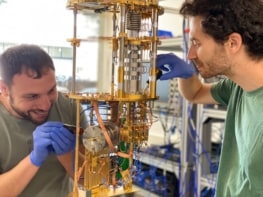In 1919 Jean Perrin proposed that certain chemical reactions known as unimolecular reactions could be explained in terms of blackbody radiation from the reaction vessel. This so-called radiation hypothesis was later discredited by Irving Langmuir but now, almost 80 years later, experiments have revitalized Perrin's idea.
In a unimolecular reaction a molecule breaks into two smaller molecules (or atoms) in a manner that appears to be independent of the chemical composition of its surrounding. The number of molecules falls exponentially with time. Perrin’s radiation hypothesis is based on two conjectures: the reacting substance has to absorb radiation at the frequency required for activation and, secondly, the radiation density had to be high enough to supply the energy for activation. Langmuir discredited the theory by pointing out that the activation energies for such reactions are in the ultraviolet frequency range and that the molecules involved are known not to absorb energy in this region.
Seventy years later researchers realized that there may be some situations in which the radiation model might work. Large molecules can absorb energy in the infrared region and the radiation density is also high enough for activation to occur. However, a lack of experimental data in the low-pressure regime caused the theory to be rejected again.
Robert Dunbar of Case Western Reserve University in the US and Terrance McMahon of the University of Waterloo in Canada have now carried out a series of experiments on alcohol compounds using a FT-ICR (Fourier transform ion cyclotron resonance) ion trap (Science 279 194-197, 1998). This apparatus is ideal for studying the low pressure reactions of molecules in a collision-free environment. The researchers noticed some striking observations: an unusual pressure dependent behaviour of the breakdown rates; and amplification of the breakdown rate when hydrogen was replaced by deuterium.
Theoretical modelling indicates that a radiation hypothesis is the only feasible explanation for the reactions observed in the experiments. The authors conclude that “the ambient blackbody radiation activation mechanism represents a major addition to the field of chemical kinetics, with particularly promising applications to cluster ions and large biomolecule ions.”



